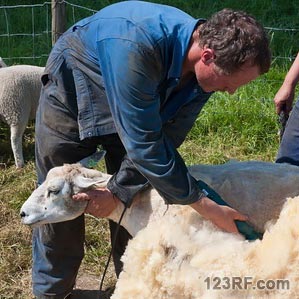Spring is a time of replenishing, rebuilding, and getting ready for summer, which is filled with work to get us ready for next winter.
It’s also an extremely busy time on the farm: there are many tasks that need doing to stay ahead of farming game, as this is the primary source of survival food for some of us.
Let’s check up the TO-DO list for spring, and see if we missed anything.
Shear the Sheep

Some breeds of sheep need sheared several times a year and some only need it once. Regardless, spring is the ideal time to do it at least once.
You’re getting rid of the long hair that kept them warm over the winter months so that your sheep can be cool and comfortable during the heat of summer.
It’s best to shear your ewes before they lamb for a couple of different reasons. First and foremost, it’s easier for the newborn lambs to nurse if Mama is sheared. They also take up less room in the birthing barn, and from a practical perspective, the wool will be much cleaner.
Re-Shoe the Horses
Your horse should be receiving farrier care every 6-8 weeks but if you’ve recently had barium shoes, ice caulks, snow-rim pads, or other shoes meant to help your horse maintain traction in the snow, you need to pull them off as soon as threat of ice or snow is over.
If not, the extra weight and traction can cause injury to legs and tendons that can cause lameness.
 Many people let their horses go barefoot over the winter in order to promote good hoof health and growth.
Many people let their horses go barefoot over the winter in order to promote good hoof health and growth.
If you’re one of those people, spring is the time to shoe them if necessary, or trim them, in order to prepare the hooves for summer work or riding.
After all, no hoof, no horse!
Grooming and Coat Care
As the weather gets warmer, your horses, dogs, goats, sheep, cattle and other furry livestock will shed winter coats and grow sleeker, shorter summer coats. This can be an itchy process that you can help by proper grooming.
Unfortunately, spring is also a time when biting lice and fleas become an issue for many animals. Keep an eye out for these small-but-troublesome creatures and deal with them as needed.
Proactive care is your best option to avoid parasites as well as dry skin, summer itch, or other skin conditions.
Get Birthing Barns or Areas Ready
Excitingly, spring is a time of birth. Typically, farm animals give birth in spring so that babies have a few months to grow and get strong enough to survive winter. It also gives Mama a few months to recover from giving birth in a less dangerous environment.
 If you’re using birthing barns or paddocks, which is a good idea if you have the room, you need to get them clean, aired out, prepared, and stocked.
If you’re using birthing barns or paddocks, which is a good idea if you have the room, you need to get them clean, aired out, prepared, and stocked.
Get your emergency medical supplies ready and make sure that you have everything on hand to ensure a healthy birthing process for your sheeps, cows, horses, pigs, and other livestock.
Spring Clean and Repair
Winter is hard on a farm: structures such as barns and outbuilding take a beating and pastures become breeding grounds for disease. Fences, gates and roofs sag from the weight of snow or from temperature changes. Machines need oil changes, safety checks, and maintenance, and pastures need picked up.
Barns and chicken coops need cleaned and aired out in preparation for birthing and storing hay and grain for the coming winter. Water and feed buckets need sterilized.
Just like you need to spring clean your house, you need to do the same for your farm so that you and your animals stay safe and healthy.If there’s a nail sticking out or a section of fence down within a 20-mile radius, rest assured that your horse will find it and injure himself on it.
Taking care of your property protects your animals and prevents costly illness and injury.
Replenish Medical Kits and Supplies
Though you should always replace supplies as you use them, spring is a great time to go through everything that you have and take an inventory. Check expiration dates and look at wraps for signs of dry-rot or mold. Build a new checklist and replenish anything that’s missing or old.
Also, if there were supplies that you ran out of or found out that you needed but didn’t have on hand, modify your supplies list this season so that you always have what you need on hand.
Final Words
Taking care of spring cleaning, maintenance, and animal health now will keep you ahead of the curve and will help keep your animals safe and healthy.
Don’t forget to stop and smell the roses, though. A nice spring trail ride or a romp with yearling goats is a great way to relieve stress and remember why you have your animals in the first place. Live, love, laugh – it’s spring!
Find out more about an amazing solution for your food independence on Pocket Farm.
This article has been written by Theresa Crouse for Survivopedia.




































































build fallout shelters for your livestock.
built sealed greenhouses and wrap as much good soil up in plastic as u can.
protect from fallout and volcanic dust.
expedient fallout shelters are simple.
expedient meansfast/short term/emergency…
even better build hardened permanent barns/shelters.